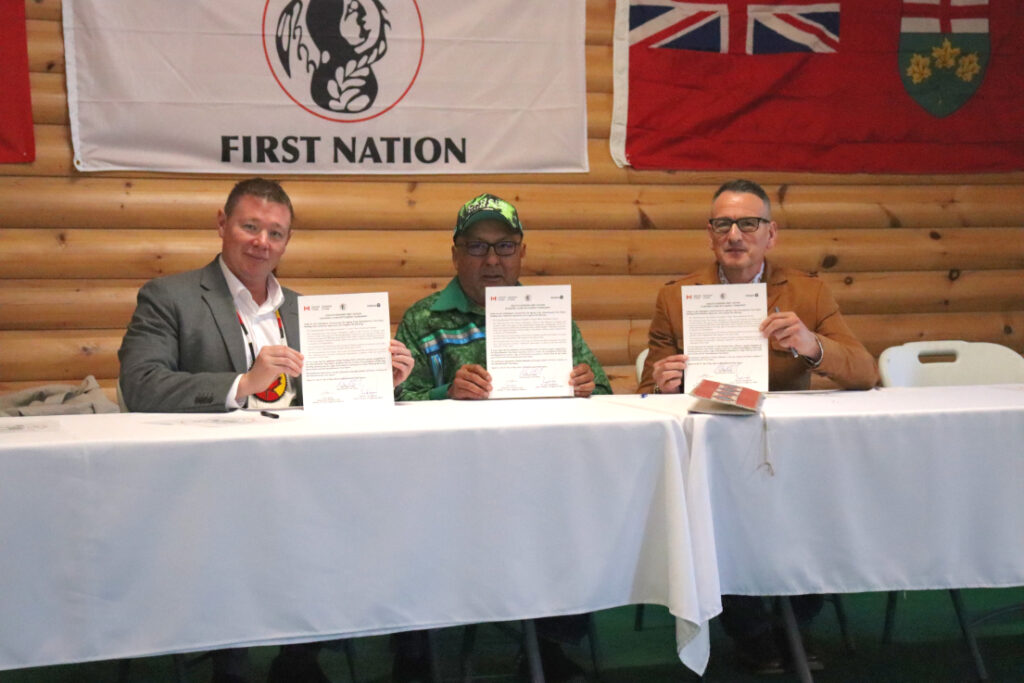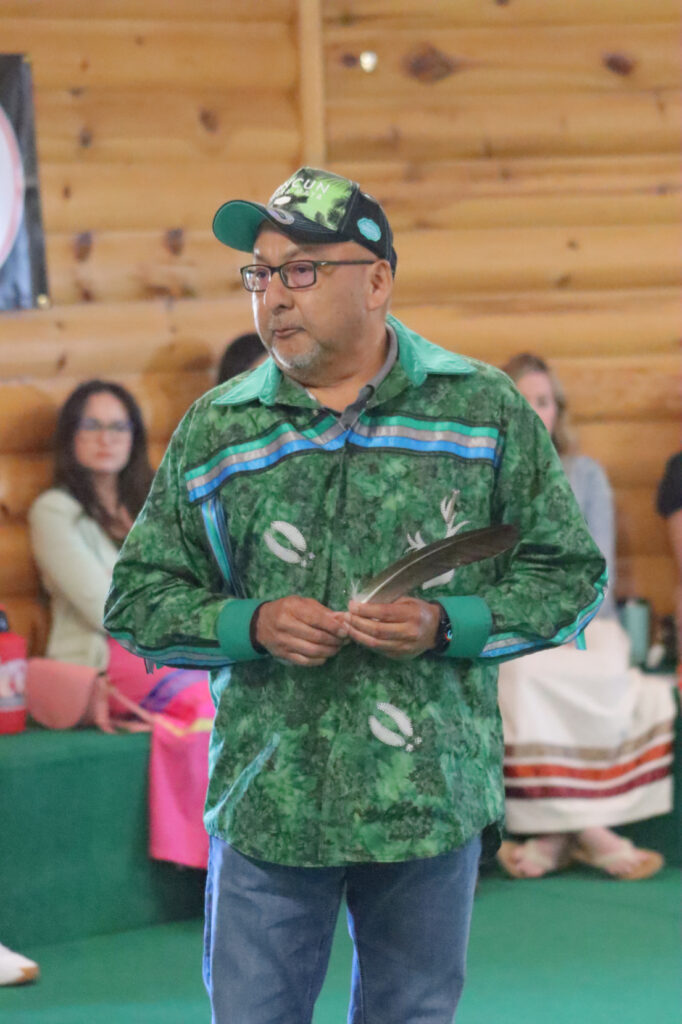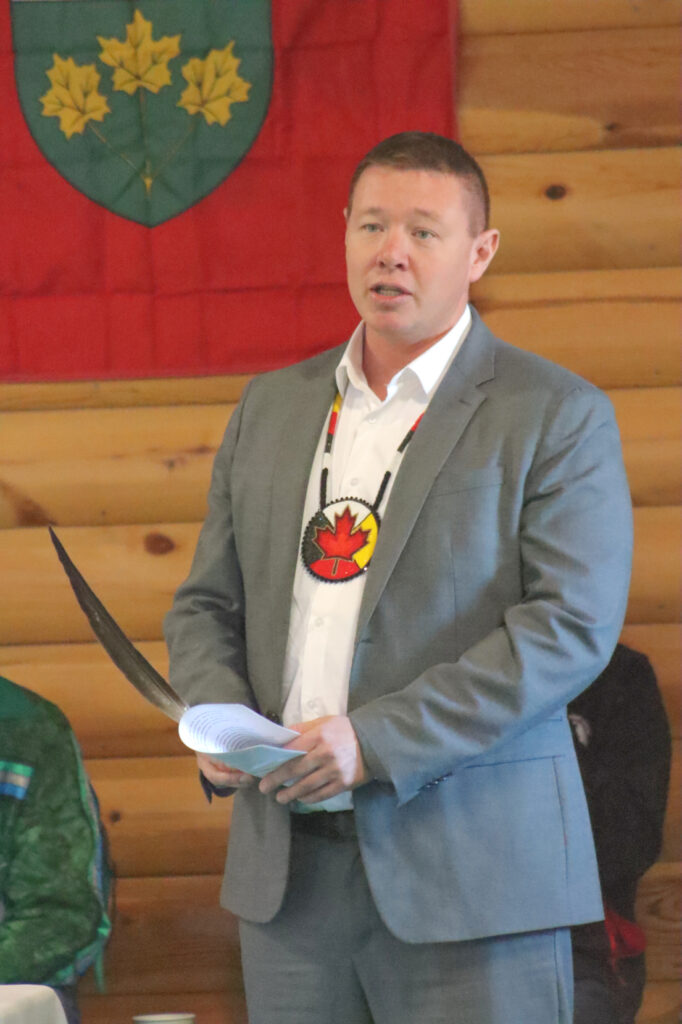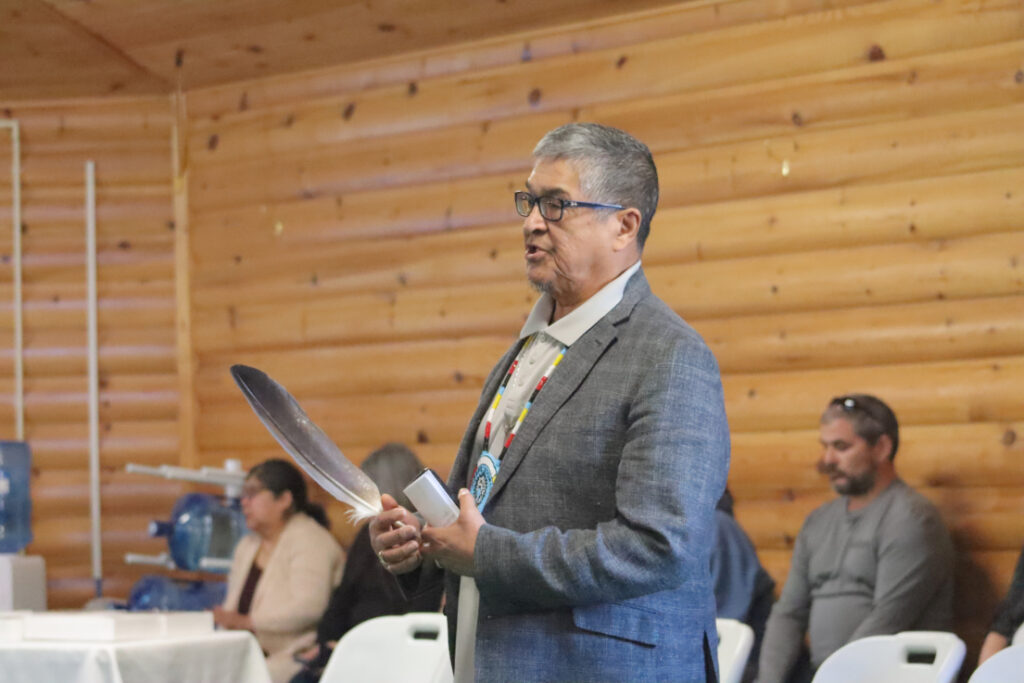As the Governments of Canada and Ontario continue to make right historic wrongs, another local First Nation community will be seeing a significant that will help them set a new course for the future.
In a ceremony held in Naicatchewenin First Nation last Thursday, May 9, 2024, chief and council, along with representatives from both the provincial and federal governments, signed a settlement to provide financial compensation for the historic flooding caused by the construction of the Fort Frances-International Falls dam in 1905.

Naicatchewenin First Nation chief Wayne Smith, along with Kenora-Rainy River MPP Greg Rickford and Parliamentary Secretary to the Minister of Crown-Indigenous Relations Jaime Battiste signed the document that officially completed the settlement negotiations and sees the First Nation community receive $21,815,877 in compensation for the historic flooding and the impact it had on the community members. The federal government will pay $11,807,068 towards the settlement, with the province of Ontario making up the remaining $10,008,809.
Clint Calder, a Naicatchewenin community member and area lawyer who worked on behalf of the community during the settlement process as legal counsel, noted that the flooding caused by the dam in Fort Frances caused catastrophic damage upstream and removed considerable area from use.
“That dam was constructed primarily for producing hydro-electricity for the paper mill in Fort Frances, but it had a negative effect on First Nations, this First Nation in particular, in that it rose the water level on Rainy Lake an average of 12 feet,” Calder said.
“We’re very fortunate in our location, but you can imagine if the water level was down 12 feet or so, that it was a much different place back then… if you fast forward to 1996, that’s when this claim was first filed with the federal government, not long after with the provincial government, and in 2009 we commenced the negotiation process for the settlement. The negotiation process was roughly 12, 13 years, and through the hard work of many people, many of whom are here today, the settlement is finally reached and that’s what we’re here today to celebrate.”
Calder shared that as part of his being involved with the negotiation, he was made aware of much of the damage caused to the community due to the loss of land by flooding, but also commended the participating parties for coming together to work out an agreement that all sides considered fair.
Chief Smith spoke to those assembled in the community’s roundhouse about the settlement, thanking them for attending the signing ceremony, and said that the settlement was indicative of advancing reconciliation between wronged First Nations and the various levels of government moving forward.
“I would like to acknowledge the hard work and determination put forth by the present and past Leadership of Naicatchewenin First Nation, along with the technicians in achieving what we believe to be fair compensation for the historical damage created by the building of the Fort Frances-International Falls Dam in 1905, which flooded our traditional lands,” Smith said.
“The Government’s efforts in honouring their legal obligation is a positive step towards addressing historical wrongs and advancing reconciliation with our Nation. We cannot compensate the ancestors who physically and mentally experienced the effects of this original action, but we will continue to invest in our Youth, Elders and Band members in the constant effort of making better lives for the people of our Nation.”
Rickford, who also sits as the province’s Minister of Indigenous Affairs, noted that it was important for the government to acknowledge the damage that had been done historically in regards to flooding and its impacts, as well as work to fix that damage.
“Several of these flooding claims have been settled in the past few years,” Rickford said.
“I want to acknowledge the nations that we’ve worked with, I want to acknowledge the partnership with Canada, our outstanding lawyers… thank you for this work, thank you for bringing us to a place today where we see reconciliation in action. We will not forget the history that tells us too much about the future, but we will be able to put some of this behind us, and move forward… together, a better and different way of working out and working through differences of opinion and adversity.”
Battiste, the parliamentary secretary to Gary Anandasangaree, Canada’s Minister of Corwn-Indigenous Relations, and himself a member of the Mi’kmaq people of Nova Scotia, also acknowledged that the federal government has a long way to go to live up to its treaty promises, but that the work together on existing harms like flooding can help to rebuild damaged relationships.
“It is my hope that this settlement agreement serves as a symbol of Canada’s dedication to renewing our relationship with the Naicatchewenin First Nation,” Battiste said.
“In this case, Canada failed to protect the reserve lands people relied on. In other instances, Canada was not a good Treaty partner. There is a lot of work ahead, but as we celebrate this step in the right direction, we also reaffirm our efforts to build trust with the people of Naicatchewenin First Nation.”
Grand Council Treaty #3 Ogichidaa Francis Kavanaugh was also in attendance at the signing, noting he was grateful to be able to be there in person to celebrate the settlement with the community. He also thanked those involved in the settlement process, that all sides were able to work together even after times when proceedings became “adversarial” and it took time for the parties to be able to come back together again.
“In the last two years I’ve seen probably a dozen of these settlements being signed off, so it’s very wonderful to see that happening,” Kavanaugh said.
According to the Government of Canada, from January 1, 2016, to March 31, 2024, 297 claims have been resolved by Canada for close to $11.1-billion in compensation. Since the Specific Claims Program began in 1973 to March 31, 2024, 702 claims totalling $14.9-billion in compensation have been settled through negotiations. In Ontario, 65 land claim and other agreements have been reached since 1983, which has totalled roughly $1-billion in payments.




Jaime Battiste; Grand Council Treaty #3 Ogichidaa Francis Kavanaugh. – Ken Kellar photos







